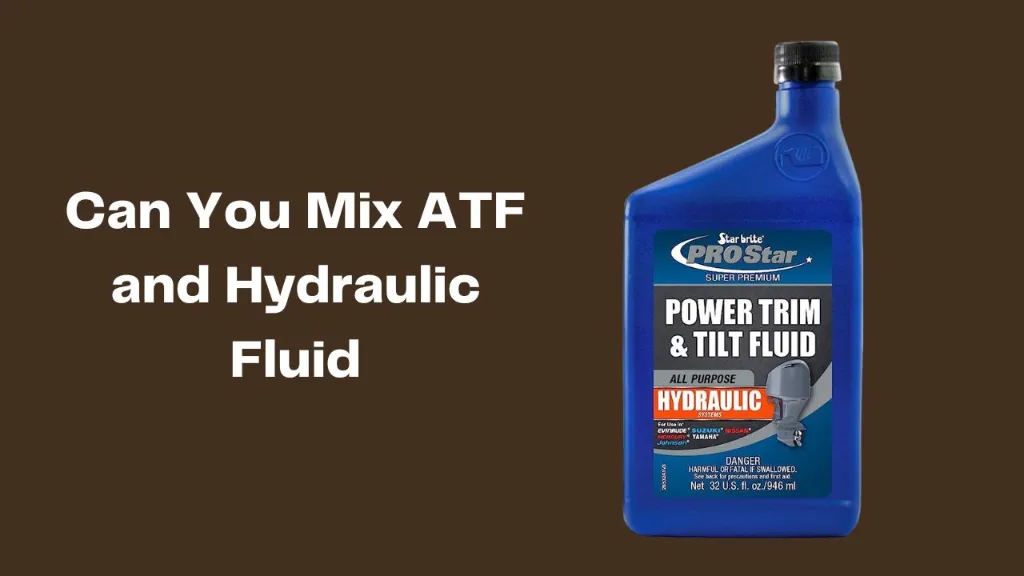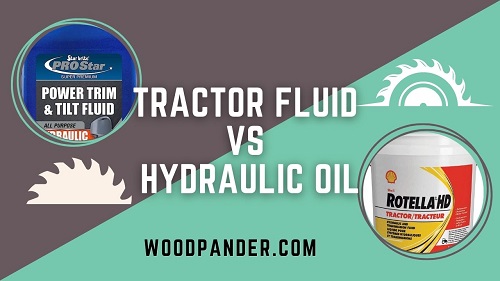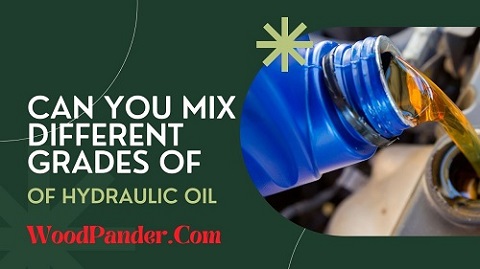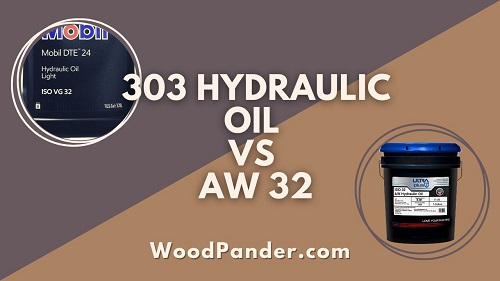Can You Mix ATF and Hydraulic Fluid?
No, it is not recommended to mix ATF (Automatic Transmission Fluid) and hydraulic fluid. Mixing these fluids can lead to a loss of desired properties and may cause damage to the system. It is important to use the correct fluid specified by the manufacturer for each application.
Hydraulic systems and automatic transmissions are vital components in various industries and vehicles, respectively. Both rely on specific fluids to operate efficiently: hydraulic fluid for hydraulic systems and automatic transmission fluid (ATF) for transmissions.
However, there is a common question among users: Can you mix ATF and hydraulic fluid?
In this article, we will delve into the compatibility of these fluids and the potential consequences of mixing them.
Hydraulic Fluid vs. Transmission Fluid
| Aspect | Hydraulic Fluid | Transmission Fluid |
|---|---|---|
| Function | Transfers power to hydraulic systems | Facilitates smooth gear shifting in transmissions |
| Composition | Oil-based or synthetic | Oil-based or synthetic |
| Viscosity | Varies depending on system requirements | Varies depending on transmission specifications |
| Additives | Contains anti-wear, anti-foam, and anti-rust additives | Contains friction modifiers, detergents, and anti-foam additives |
| Pressure | Designed to withstand high pressures | Designed for lower operating pressures |
| Temperature Range | Wide temperature range (typically -40°C to 120°C) | Moderate temperature range (typically -20°C to 150°C) |
| Compatibility | Compatible with various hydraulic systems | Compatible with specific transmission types |
| Lubrication | Provides lubrication and cooling to hydraulic components | Provides lubrication and cooling to transmission components |
| Purpose | Transfers force and motion in hydraulic systems | Transfers engine power to the wheels in vehicles |
| Color | Can be various colors (e.g., red, yellow, blue) | Typically red or pink in color |
| System Design | Uses hydraulic pumps, motors, and cylinders | Includes gears, clutches, and torque converters |
| Maintenance | Requires regular fluid checks and changes | Requires periodic fluid checks and changes |
| Common Applications | Industrial machinery, construction equipment | Automotive vehicles, trucks, and motorcycles |
One of our articles –Tractor Fluid vs Hydraulic Oil.
What is ATF?
Automatic Transmission Fluid (ATF) is a specialized lubricant used in automatic transmissions. It serves multiple purposes, including lubricating moving parts, cooling the transmission, and transmitting power.
ATF is formulated with specific additives to meet the requirements of automatic transmissions, providing optimal performance and longevity.
| ATF Type | Dexron III | Mercon V | Dexron VI | Toyota ATF-WS | Honda DW-1 |
|---|---|---|---|---|---|
| Manufacturer | General Motors | Ford | General Motors | Toyota | Honda |
| Color | Red | Red | Red | Red | Red |
| Compatibility | Compatible with most domestic and imported vehicles prior to 2006 | Compatible with most Ford vehicles | Compatible with most GM vehicles | Specifically formulated for Toyota vehicles | Specifically formulated for Honda vehicles |
| Fluid Life | 30,000-50,000 miles | 30,000-50,000 miles | 50,000-100,000 miles | 100,000 miles | 60,000 miles |
| Viscosity | Medium | Medium | Low | Low | Low |
| Performance | Good shifting performance and heat resistance | Good shifting performance and heat resistance | Enhanced oxidation resistance and improved fuel efficiency | Excellent shear stability and friction control | Excellent lubrication and wear protection |
| Price Range (per quart) | $5-$10 | $5-$10 | $8-$15 | $10-$20 | $10-$15 |
One of our articles – Can You Use Brake Fluid in Hydraulic Jack?
What is Hydraulic Fluid?
Hydraulic Fluid, also known as hydraulic oil, is a medium used in hydraulic systems to transmit power.
It is responsible for lubrication, heat dissipation, and sealing within the system. Hydraulic Fluids are designed to withstand high pressures and varying temperatures, ensuring smooth operation of hydraulic machinery and equipment.
| Hydraulic Fluid Type | Mineral Oil | Synthetic Oil | Biodegradable | Fire-Resistant |
|---|---|---|---|---|
| Composition | Refined | Synthetic | Organic | Synthetic |
| Base Oil | Mineral Oil | Synthetic Oil | Vegetable Oil | Synthetic Oil |
| Viscosity Range | Wide range | Wide range | Wide range | Wide range |
| Temperature Range | Limited | Wide range | Limited | Limited |
| Water Resistance | Poor | Excellent | Varies | Varies |
| Oxidation Stability | Moderate | High | Moderate | High |
| Foam Resistance | Poor | Excellent | Good | Excellent |
| Compatibility | Most systems | Most systems | Limited | Limited |
| Environmental Impact | Low | Low | Biodegradable | Low |
| Price | Affordable | Expensive | Moderate | Expensive |
Can You Mix ATF and Hydraulic Fluid?

The short answer is no, you should not mix ATF and Hydraulic Fluid. While both fluids share similarities in terms of lubrication and heat dissipation, they have different compositions and purposes. Mixing them can lead to adverse effects on the equipment and its performance.
| Aspect | Mixing ATF and Hydraulic Fluid |
|---|---|
| Compatibility | ATF and hydraulic fluid are generally not compatible and should not be mixed. |
| Performance | Mixing can result in compromised performance of both the transmission and hydraulic system. |
| Viscosity | ATF and hydraulic fluid have different viscosity levels, which can lead to improper lubrication and potential damage. |
| Sealing and Swelling | The rubber seals and O-rings in the system may swell or degrade when exposed to the wrong fluid, causing leaks and system malfunctions. |
| Heat Dissipation | Mixing fluids with different heat dissipation properties can lead to overheating and reduced cooling effectiveness. |
| Additives | ATF and hydraulic fluid contain different additives tailored for their specific applications, and mixing them can dilute or alter the desired additive properties. |
| System Damage | Mixing can potentially cause damage to valves, seals, pumps, and other components due to improper lubrication and fluid characteristics. |
| Warranty and Manufacturer’s Note | Mixing fluids may void warranties and is typically not recommended by manufacturers. Always consult the manufacturer’s recommendations. |
One of our articles – Can You Mix Different Brands Of Hydraulic Fluid?
Consequences of Mixing ATF and Hydraulic Fluid
Mixing ATF and Hydraulic Fluid can result in several detrimental effects. Here are some of the potential consequences:
- Poor Lubrication: ATF and Hydraulic Fluid have different viscosities and lubricating properties. Mixing them may compromise the lubrication system, leading to increased friction, wear, and potential damage to the equipment.
- Reduced Performance: Mixing incompatible fluids can cause the hydraulic system to function improperly. This can result in decreased power transmission, reduced efficiency, and compromised overall performance.
- Seal and O-Ring Damage: ATF and Hydraulic Fluid have different chemical compositions. Mixing them may cause the seals and O-rings within the system to deteriorate, leading to leaks and potential system failure.
- Foaming and Air Entrapment: Mixing incompatible fluids can lead to foaming and air entrainment within the hydraulic system. This can hinder the smooth operation of components, resulting in decreased efficiency and potential damage.
Factors to Consider when Mixing Fluids
If you find yourself in a situation where you need to mix fluids, it is essential to consider the following factors:
- Fluid Compatibility: Ensure that the fluids you intend to mix are chemically compatible. Consult the equipment manufacturer’s recommendations or seek professional advice to determine compatibility.
- Viscosity and Operating Temperatures: The viscosity and operating temperature range of the fluids should align to prevent issues such as poor lubrication and increased wear.
- Additive Interactions: Different fluids contain additives that can react when mixed. Consider the potential interactions between additives to avoid any adverse effects.
- System Contamination: Mixing fluids can introduce contaminants into the system. Take precautions to minimize the risk of contamination and perform regular fluid analysis to monitor the system’s condition.
Best Practices for Fluid Mixing
While it’s generally recommended to avoid mixing ATF and Hydraulic Fluid, there are some instances where it may be necessary. If mixing is required, follow these best practices:
- Consult the Manufacturer: Always refer to the equipment manufacturer’s guidelines and recommendations regarding fluid compatibility and mixing.
- Drain and Flush the System: If switching from one fluid type to another is necessary, it’s crucial to drain and flush the system thoroughly to remove any residual fluid.
- Use Compatible Fluids: If an alternative fluid is required, ensure it is compatible with the system and meets the manufacturer’s specifications. Seek expert advice if needed.
- Monitor and Test: Regularly monitor the system’s performance and conduct fluid analysis to detect any abnormalities or potential issues.
Is there any Compatible Fluid?
There are some specialized fluids available that can be used as a substitute for both ATF and Hydraulic Fluid.
However, it is crucial to consult the equipment manufacturer or a knowledgeable professional to determine the compatibility and suitability of these alternatives.
How to Properly Dispose of Mixed Fluids
If you have accidentally mixed ATF and Hydraulic Fluid, it is important to dispose of the mixture properly. Here are some guidelines to follow:
- Check Local Regulations: Familiarize yourself with local regulations regarding the disposal of mixed fluids. Some areas have specific guidelines for handling and disposing of hazardous substances.
- Contact Recycling Centers or Service Providers: Reach out to recycling centers or specialized service providers that handle hazardous waste. They can guide you on the proper disposal methods and facilitate safe handling.
- Do Not Dump or Pour: Avoid dumping or pouring mixed fluids into drains, water sources, or the environment. Improper disposal can have severe consequences on the ecosystem.
Related Questions
Can I use ATF in a hydraulic system that specifies Hydraulic Fluid?
It is not recommended. Hydraulic systems have specific requirements, and using the wrong fluid can lead to performance issues and potential damage.
Can mixing ATF and Hydraulic Fluid cause equipment warranty voidance?
Yes, mixing fluids can potentially void the equipment warranty. Always follow the manufacturer’s guidelines to ensure warranty coverage.
What happens if I accidentally mix ATF and Hydraulic Fluid?
Accidentally mixing these fluids can have detrimental effects on equipment performance, leading to increased wear, reduced efficiency, and potential system failure.
Can I dilute ATF with Hydraulic Fluid to adjust viscosity?
No, diluting ATF with Hydraulic Fluid is not recommended. It can lead to improper lubrication and compromised system performance.
Are there any additives available to make ATF and Hydraulic Fluid compatible?
There are no additives available to make ATF and Hydraulic Fluid chemically compatible. It is best to avoid mixing these fluids altogether.
Conclusion
Mixing ATF and Hydraulic Fluid can have serious consequences on the performance and longevity of equipment. It is important to understand the incompatibilities between these fluids and the potential risks associated with mixing them.
Whenever possible, follow the manufacturer’s recommendations and guidelines for fluid maintenance, and consult experts if needed. By ensuring proper fluid compatibility and adhering to best practices, you can protect your equipment and optimize its performance in the long run.








